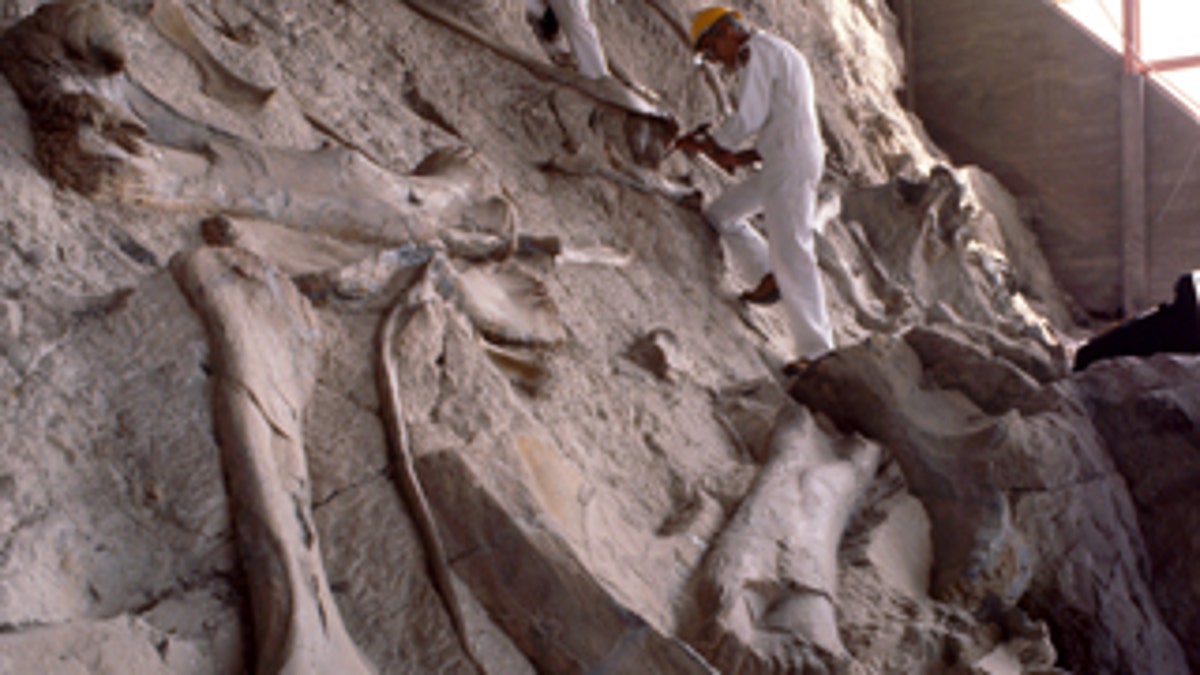
VERNAL, Utah – Local legend has it that cowboys, sheep herders and trappers long knew about the huge fossilized bones that regularly surfaced from the ancient rock underlying Utah's dinosaur country.
But not until steel magnate Andrew Carnegie learned of the bones did Vernal and the surrounding Ashley Valley get the nation's attention 100 years ago. Now Vernal, a Western outpost whose wide streets are lined with energy, mining and agricultural businesses, makes a business of its bones. It's home to a large dinosaur museum and is the base for a National Park Service site at a bone quarry Carnegie established in 1909.
Carnegie's bone quarry is the central dinosaur-related attraction of the area. Located 20 miles outside of Vernal, it's part of Dinosaur National Monument, a 210,000-acre park with rocky and rippled canyonlands stretching into Utah and Colorado.
The park is best known for its visitors' center, with a wall of 1,500 fossilized bones from 11 different types of dinosaurs. In 2005, the visitors center, which sits atop Carnegie's bone quarry, was closed because of severe structural problems.
It's not expected to open again until 2012. But there is still plenty to see. A bed of fossilized bones extends outside the shuttered building. A trail nearby passes fossils naturally eroded from a cliff, including a string of vertebrae, a large femur, and a humurus bone.
The park has a temporary visitors center with fossils and a gift shop featuring giant replica dinosaur bones to take home.
And there is a lot more at the park than bones. Fremont Indians who lived near the park's two rivers about 1,000 years ago left behind both petroglyphs (patterns that are chipped or carved into the rock) and pictographs (drawings or paintings on the rock). They can be seen at remote sites accessible by foot or car.
The park is also spectacular in itself, a rolling bed of multicolored rock cliffs and formations showing the movement of the earth over hundreds of millions of years.
"The cliffs and sculptured forms are sometimes smooth, sometimes fantastically craggy, always massive, and they have a peculiar capacity to excite the imagination," wrote author Wallace Stegner in a book of essays, "Dinosaur," that Stegner edited in 1955 when there was talk of converting the park's Yampa and Green canyons into a reservoir for a hydroelectric dam. "The effect on the human spirit is neither numbing nor awesome, but infinitely peaceful," wrote Stegner.
Dinosaur bones are found on every continent. But Utah's Uinta Basin is unique because of the way that the rock shows the ancient remains. Originally the rocks, formed from lake and floodplain sediment, lay flat. Over millions of years, the movement of the earth pushed the massive stone layers until they now point at the sky. Erosion has worn away the rock, revealing the bones.
The result: "There's just no other place anywhere on the planet where they're just so beautifully exposed for the public to see. It's the most famous place to see dinosaurs still in their host rock anywhere in the world," said Jim Kirkland, the Utah state paleontologist, who works for the Utah Geological Survey. "There is no place as spectacular as Dinosaur."
The valley holds lesser-known attractions. Settlers entered in the late 1800s, many of them members of The Church of Jesus Christ of Latter-Day Saints in search of a place where they could practice their religion free from persecution.
Outlaws such as Butch Cassidy spent time hiding out in an isolated valley called Brown's Park near Vernal and visiting the local saloons.
The outlaws' protected valley is still farmed, but of the outlaws' homes and the businesses they used, little remains, said Ellen Kiever, a clerk in the county's well-stocked history center. Nevertheless, the county holds events to remember the outlaws and the farmers who lived with them side-by-side. Every year a dance is put on at the old schoolhouse. There's also a John Jarvie festival each Father's Day, in honor of a Scotsman who settled in Browns Park in 1880 and built a ranch, store, cemetery, post office and river ferry.
This year is the 100th anniversary of the dinosaur discovery that led to the establishment of the Dinosaur National Monument. In some local histories, a Dr. Earl Douglass, sent West by Carnegie to find fossils for his Hall of Vertebrate Paleontology in Pittsburgh, gets credit for finding the bones and recognizing their significance. Others say the credit should go to another man: goat herder Johnny Harper, who found a huge petrified bone in what became the Carnegie quarry and told everyone in town.
"Johnny went on with his duties of caring for the goats and never got recognition for this historic find," wrote local historian George Long in a 2007 narrative history.
Click here for more from FOX News Travel
